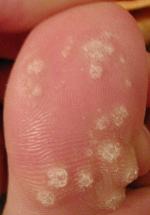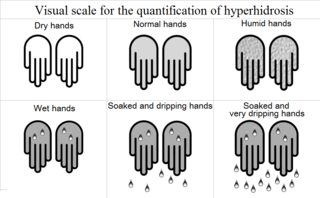Related Research Articles

Ketoprofen is one of the propionic acid class of nonsteroidal anti-inflammatory drugs (NSAID) with analgesic and antipyretic effects. It acts by inhibiting the body's production of prostaglandin.

Warts are non-cancerous viral growths usually occurring on the hands and feet but which can also affect other locations, such as the genitals or face. One or many warts may appear. They are distinguished from cancerous tumors as they are caused by a viral infection, such as a human papillomavirus, rather than a cancerous growth.

Acne, also known as acne vulgaris, is a long-term skin condition that occurs when dead skin cells and oil from the skin clog hair follicles. Typical features of the condition include blackheads or whiteheads, pimples, oily skin, and possible scarring. It primarily affects skin with a relatively high number of oil glands, including the face, upper part of the chest, and back. The resulting appearance can lead to lack of confidence, anxiety, reduced self-esteem, and, in extreme cases, depression or thoughts of suicide.

A plantar wart is a wart occurring on the bottom of the foot or toes. Its color is typically similar to that of the skin. Small black dots often occur on the surface. One or more may occur in an area. They may result in pain with pressure such that walking is difficult.

Tretinoin, also known as all-trans retinoic acid (ATRA), is a medication used for the treatment of acne and acute promyelocytic leukemia. For acne, it is applied to the skin as a cream, gel or ointment. For leukemia, it is taken by mouth for up to three months. Topical tretinoin is also the most extensively investigated retinoid therapy for photoaging.

Dapsone, also known as 4,4'-sulfonyldianiline (SDA) or diaminodiphenyl sulfone (DDS), is an antibiotic commonly used in combination with rifampicin and clofazimine for the treatment of leprosy. It is a second-line medication for the treatment and prevention of pneumocystis pneumonia and for the prevention of toxoplasmosis in those who have poor immune function. Additionally, it has been used for acne, dermatitis herpetiformis, and various other skin conditions. Dapsone is available both topically and by mouth.

Benzoyl peroxide is a chemical compound (specifically, an organic peroxide) with structural formula (C6H5−C(=O)O−)2, often abbreviated as (BzO)2. In terms of its structure, the molecule can be described as two benzoyl (C6H5−C(=O)−, Bz) groups connected by a peroxide (−O−O−). It is a white granular solid with a faint odour of benzaldehyde, poorly soluble in water but soluble in acetone, ethanol, and many other organic solvents. Benzoyl peroxide is an oxidizer, which is principally used as in the production of polymers.

Hyperhidrosis is a medical condition in which a person exhibits excessive sweating, more than that required for regulation of body temperature. Although primarily a benign physical burden, hyperhidrosis can deteriorate quality of life from a psychological, emotional, and social perspective. In fact, hyperhidrosis almost always leads to psychological as well as physical and social consequences. People suffering from it present difficulties in the professional field, more than 80% experiencing a moderate to severe emotional impact from the disease and half are subject to depression.

Adapalene is a third-generation topical retinoid primarily used in the treatment of mild-moderate acne, and is also used off-label to treat keratosis pilaris as well as other skin conditions. Studies have found adapalene is as effective as other retinoids, while causing less irritation. It also has several advantages over other retinoids. The adapalene molecule is more stable compared to tretinoin and tazarotene, which leads to less concern for photodegradation. It is also chemically more stable compared to the other two retinoids, allowing it to be used in combination with benzoyl peroxide. Due to its effects on keratinocyte proliferation and differentiation, adapalene is superior to tretinoin for the treatment of comedonal acne and is often used as a first-line agent. The Swiss company Galderma sells adapalene under the brand name Differin.

Hyperpigmentation is the darkening of an area of skin or nails caused by increased melanin.

Aluminium chloride, also known as aluminium trichloride, is an inorganic compound with the formula AlCl3. It forms a hexahydrate with the formula [Al(H2O)6]Cl3, containing six water molecules of hydration. Both the anhydrous form and the hexahydrate are colourless crystals, but samples are often contaminated with iron(III) chloride, giving them a yellow colour.

Azelaic acid (AzA) is an organic compound with the formula HOOC(CH2)7COOH. This saturated dicarboxylic acid exists as a white powder. It is found in wheat, rye, and barley. It is a precursor to diverse industrial products including polymers and plasticizers, as well as being a component of a number of hair and skin conditioners. AzA inhibits tyrosinase.

Clindamycin/benzoyl peroxide is a topical gel used for the treatment of acne. It is a fixed-dose combination of clindamycin, as the phosphate, an antibiotic, and benzoyl peroxide, an antiseptic.

Oxybutynin, sold under the brand name Ditropan among others, is an anticholinergic medication primarily used to treat overactive bladder. It is widely considered a first-line therapy for overactive bladder due to its well-studied side effect profile, broad applicability, and continued efficacy over long periods of time. It works similar to tolterodine, darifenacin, and solifenacin, although it is usually preferred over these medications. It is sometimes used off-label for treatment of hyperhidrosis, or excessive sweating. It has also been used off-label to treat bed wetting in children, but this use has declined, as it is most likely ineffective in this role. It is taken by mouth or applied to the skin.

Nadifloxacin is a topical fluoroquinolone antibiotic for the treatment of acne vulgaris. It is also used to treat bacterial skin infections.

Palmoplantar hyperhidrosis is excessive sweating localized to the palms of the hands and soles of the feet. It is a form of focal hyperhidrosis in that the excessive sweating is limited to a specific region of the body. As with other types of focal hyperhidrosis the sweating tends to worsen during warm weather.

Adapalene/benzoyl peroxide, sold under the brand name Epiduo among others, is a fixed-dose combination medication for the treatment of severe acne vulgaris. It consists of a combination of adapalene and benzoyl peroxide in a topical gel formulation.

Focal hyperhidrosis, also known as primary hyperhidrosis, is a disease characterized by an excessive sweating localized in certain body regions. Studies suggest that this condition, affecting between 1% and 3% of the US population, seems to have a genetic predisposition in about two thirds of those affected.

Abrocitinib, sold under the brand name Cibinqo, is a medication used for the treatment of atopic dermatitis (eczema). It is a Janus kinase inhibitor and it was developed by Pfizer. It is taken by mouth.

Sofpironium bromide is a drug used to treat hyperhidrosis. It was approved in Japan in 2020 as a 5% gel for the treatment of primary axillary hyperhidrosis (PAH).
References
- ↑ "Aluminum Chloride Hexahydrate topical Monograph for Professionals". Drugs.com. Retrieved 5 November 2019.
- ↑ Woolery-Lloyd, Heather; Whitney Valins (July 2011). "Aluminum chloride hexahydrate in a salicylic acid gel base: a case series of combination therapy with botulinum toxin type A for moderate to severe hyperhidrosis". Cutaneous Medicine for the Practitioner. 88 (1): 43–45. PMID 21877507.
- ↑ Flanagan, Katherine H.; Dee Anna Glaser (May 2009). "An open-label trial of the efficacy of 15% aluminum chloride in 2% salicylic acid gel base in the treatment of moderate-to-severe primary axillary hyperhidrosis". Journal of Drugs in Dermatology. 8 (5): 477–480. PMID 19537371.
- ↑ Benohanian, Antranik; Alain Dansereau; Chantal Bolduc; Ernest Bloom (September 1998). "Localized hyperhidrosis treated with aluminum chloride in a salicylic acid gel base". International Journal of Dermatology. 37 (9): 701–703. doi:10.1046/j.1365-4362.1998.00543.x. PMID 9762825.